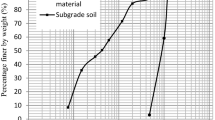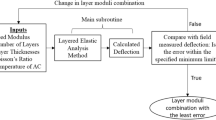Abstract
Assessing the performance of existing pavement structures, is quite challenging. The repeated triaxial load tests on cylindrical specimens are routinely used to measure the resilient capacity of pavement. The resilient modulus (M_R) testing equipment, is not readily available in an in-situ setup as a result of the complexities of the test protocol. This study investigated the performance and causes of distress identified on existing highway along Eastern Nigeria (Enugu - Abakaliki–Ikom Highway Road). Series of dynamic cone penetration (DCP) tests were conducted and the results were analysed by AFCP-LVR software. California Bearing Ratio (CBR) and Resilient modulus tests were performed to investigate the causes of deterioration on this pavement structure. The results confirmed that the investigated pavement structure failed on the surface, as a result of excessive traffic loads from heavy trucks. The test results further revealed that the asphaltic layer is the only failed layer of the pavement structure. The investigate pavements were confirmed to be designed for low-volume traffics, according to CBR and M_R test results. The predicted CBR, and M_R values from AFCP-LVR software analysis, indicated average variations of 2.8%, and 3.6MPa, respectively compared to the laboratory measured values. This study revealed that excessive traffic load is the major cause of distress on the investigated pavement. The pavement analysis suggested that dynamic cone penetrometer is a suitable tool for assessing the resilient performance of substructures in pavement.
Similar content being viewed by others
Change history
29 April 2020
After publication of this work [1], author requested the correction of the Second author’s name Mohamed Hassan Mostafa and Corresponding author’s email Anekef@uj.ac.za.Those have now been updated. We are publishing this erratum to update the Second author’s name as Mohamed M. H. Mostafa and Corresponding author’s email to Anekef@ukzn.ac.za.
29 April 2020
After publication of this work [1], author requested the correction of the Second author’s name Mohamed Hassan Mostafa and Corresponding author’s email Anekef@uj.ac.za.Those have now been updated. We are publishing this erratum to update the Second author’s name as Mohamed M. H. Mostafa and Corresponding author’s email to Anekef@ukzn.ac.za.
References
Federal Highway Administration, Federal highway administration traffic monitoring guide. FHWA Federal Highway administration, Washington DC, USA, 2013.
R.Y. Liang, S. Rabab'ah, M. Khasawneh, Predicting moisture-dependent resilient modulus of cohesive soils using soil suction concept, J. Transp. Eng. 134 (1) (2008) 34–40. doi.org/10.1061/(ASCE)0733-947X (2008)134:1(34)
M. Mejías-Santiago, L. García, L. Edwards, Assessment of Material Strength Using Dynamic Cone Penetrometer Test for Pavement Applications. In: John Harvey and Katie F. Chou, eds. Airfield and highway pavements, American Society of Civil Engineering, Miami, FL, USA, 2015, pp. 837–848 doi: 10.1061/9780784479216.074
O.S. Al-Amoudi, S. A. Aiban, A. M. Hamid, Assessment of Dynamic Cone Penetration Test to Assess the Engineering Properties of Saudi Sands, The Eighth International Structural Engineering and Construction Conference, Sydney, Australia, 2015. DOI: 10.14455/ISEC.res.2015.220
H. Amiri, S. Nazarian, E. Fernando, Investigation of impact moisture variation on response of pavement through small-scale model, J Mater. Civ. Eng. 21 (10) (2009) 553–560.
B.T. Nguyen, A. Mohajerani, A new lightweight dynamic cone penetrometer for laboratory and field application, J. News Australian Geomech. Soci. 47 (2) (2012}) 41–
A. A. Rahman, M. R. Islam, R. A. Tarefder, Assessment and modification of nationally-calibrated dynamic modulus predictive model for the implementation of Mechanistic-Empirical design, Inter. J. Pavement Res. Technol. 11 (5)
A. Herath, L. N. Mohammad, K. Gaspard, R. Gudishala, M. Abu-Farsakh, The Use of Dynamic Cone Penetrometer to Predict Resilient Modulus of Subgrade Soils, International Conference, Geo-Frontiers Congress 2005, Austin, Texas, USA, 2005, pp. 1–16. DOI: 10.1061/40776(155)2
E.G. Kleyn, L. F. De Wet, P.F. Savage, The development of an equation for the Strength Balance of Road Pavement Structures, The Civil Engineer in South Africa 31 (2) (1989) 45–50.
J. P. Lambert, P. R. Fleming, M.W. Frost, The assessment of coarse granular materials for performance-based pavement foundation design, Inter. J. Pavement Eng. 9 (3) (2008) 203–214. doi.org/10.1080/10298430701409392
A. M. Rahim, Subgrade soil index properties to estimate resilient modulus for pavement design, Inter. J. Pavement Eng. 6 (3) (2008) 163–169. doi: 10.1080/10298430500140891
L. N. Mohammad, A. Herath, M. Y. Abu-Farsakh, K. Gaspard, R. Gudishala, Prediction of resilient modulus of cohesive subgrade soils from dynamic cone penetrometer test parameters, J. Mater. Civ. Eng. 19 (11) (2007) 986–992. doi: 10.1061/(ASCE)0899.1561(2007)19:11(986)
V. George, N. C. Rao, R. Shivashankar, PFWD, DCP and CBR Correlations for evaluation of lateritic subgrades, Inter. J. Pavement Eng. 10 (3) (2009) 189–199. DOI: 10.1080/10298430802342765
J. Siekmeier, C. Pinta, S. Merth, J. Jensen, P. Davich, F. Camargo, M. Beyer, Using the Dynamic Cone Penetrometer and Light Weight Deflectometer for Construction Quality Assurance. MN/RC 2009-12. Minnesota Department of Transportation, Minnesota, USA, 2009, p. 244
D. Chukka, V. Chakravarthi, Evaluation of properties of soil subgrade using dynamic cone penetration Index–A Case Study, Inter. J. Eng. Res. Develop. 4 (4) (2012) 7–15.
S.R. Yang, W. H. Huang, Tai, Y. T. Variation of resilient modulus with soil suction for compacted subgrade soils, Transp. Res. Rec. 1913 (2005) 99–106. doi:10.3141/1913-10.
A.A. Amadi, S. Sadiku, M. Abdullahi, H. A. Danyaya, Case study of construction quality control monitoring and strength evaluation of a lateritic pavement sing the dynamic cone penetrometer, Inter. J. Pavement Res. Technol. 11 (5) (2018) 530–539, https://doi.org/10.1016/j.ijprt.2018.07.001
M. Mejías-Santiago, M. García, L. Edwards, Assessment of Material Strength Using Dynamic Cone Penetrometer Test for Pavement Applications, Airfield and Highway:ovative and Cost-Effective Pavements for a Sustainable Future, Miami, Florida, USA, 2015, pp. 837–848. doi: 10.1061/9780784479216.074
K. P. George, W. Uddin, Subgrade Characterization for Highway Pavement Design. No. FHWA/MS-DOT-RD-00-131. Mississippi Department of Transportation, Jackson, MS. USA, 2000.
F. Lekarp, U. Isacsson, A. Dawson, State of the art. I: Resilient response of unbound aggregates, J. Transp. Eng. 126 (1) (2000) 66–75. doi:10.1061/(ASCE)0733-947X(2000)126:1(66).doi.org/10.1061/(ASCE)0733-947X (2000)126:1(76)
R. Gudishala, Development of resilient modulus prediction models for base and subgrade pavement layers from in situ devices test results, (PhD thesis), Sri Krishnadevaraya University, Anantapur, India, 2004.
M. Mejías-Santiago, L. García, L. Edwards, Assessment of Material Strength Using Dynamic Cone Penetrometer Test for Pavement Applications, Airfield and Highway Pavements: Innovative and Cost-Effective Pavements for a Sustainable Future, Miami, Florida, USA, 2015, pp. 837–848. doi: 10.1061/9780784479216.074
M.M.E. Zumrawi, Prediction of In-situ CBR of Subgrade Cohesive Soils from Dynamic Cone Penetrometer and Soil Properties, IACSIT Inter. J. Eng. Technol. 6 (5) (2014) 439–442. doi: 10.7763/IJET. 2014.V6.738
M. Morvan, Wong, Branque, D. An unsaturated soil model with minimal number of parameters based on bounding surface plasticity, Inter. J. Numerical Analytical Methods Geomech. 34 (14) (2010) 1512–1537. doi:10.1002/nag.871.
D. G. Fredlund, H. Rahardjo, M.D. Fredlund, Unsaturated soil mechanics in engineering practice., A Wiley-Interscience Publication, John Wiley & Sons, Inc, 2012, p. 535.
C. E. Cary, C. E. Zapata, Enhanced model for resilient response of soils resulting from seasonal changes as implemented in mechanistic-empirical pavement design guide, Transp. Res. Rec. 2170 (1) (2014) 36–44.
A.B. Parreira, R. F. Goncalves, The influence of moisture content and soil suction on the resilient modulus of a lateritic subgrade soil, Presented at GeoEng - An international conference on geotechnical & geological engineering, Melbourne, Australia, 2000.
C. E. Zapata, Y. Y. Perera, W. N. Houston, Matric Suction Prediction Model in new AASHTO Mechanistic-Empirical Pavement Design Guide, Transp. Res. Rec. 2101 (1) (2009) 53–62. doi.org/10.3141/2101-07
N. N. Khoury, M. M. Zaman, Correlation between resilient modulus, moisture variation, and soil suction for subgrade soils, Transp. Res. Rec. 1874 (1) (2004) 99–107. doi:10.3141/1874-11
C.E. Zapata, W. N. Houston, S.L. Houston, K.D. Walsh, Soil-Water Characteristic Curve Variability, Adv. Unsaturated Geotech. Geotechnical Special Publication 9 (2000) 84–124. doi.org/10.1061/40510(287)7
R. Y. Liang, S. Rabab'ah, M. Khasawneh, Predicting moisture-dependent resilient modulus of cohesive soils using soil suction concept, J. Transp. Eng. 134 (1) (2008) 34–40. doi.org/10.1061/(ASCE)0733-947X (2008)134:1(34)
M. S. Cary, C. Ernesto, C. E. Zapata, Resilient Modulus Testing for Unsaturated Unbound Materials, Inter. J. Road Mater. Pavement Des. 12 (3) (2011) 615–638.
H. Nowamooz, C. Chazallon, M. I. Arsenie, P. Hornych, F. Masrouri, Unsaturated resilient behaviour of a natural compacted sand, Comput. Geotech. 38 (4) (2011) 491–503. doi: 10.1016/j.compgeo.2011.02.013
C.W.W. Ng, C. Zhou, Q. Yuan, J. Xu, Resilient modulus of unsaturated subgrade soil. Experimental and technical investigations, Can. Geotech. 50 (2) (2013) 223–232. doi.org/10.1139/cgj-2012-0052
American Society for Testing and Materials, Standard Test Methods for Determining the Amount of Material Finer than 75-µm (No. 200) Sieve in Soils by Washing. ASTM D1140–17. ASTM International, West Conshohocken, PA, 2017.
American Society for Testing and Materials, Standard test method for determination of water (moisture) content of soil by direct heating. Designation D4959-2000. ASTM International, West Conshohocken, PA, 2000.
American Society for Testing and Materials, Standard Test Method for Determination of Soil Density by Drive-Cylinder Method, ASTM International, West Conshohocken, PA, 2004.
American Society for Testing and Materials, Standard Test Method for Use of the Dynamic Cone Penetrometer in Shallow Pavement Applications. D6951-03. ASTM International, West Conshohocken, PA, 2003.
J. Siekmeier, C. Pinta, S. Merth, J. Jensen, P. Davich, F. Camargo, M. Beyer, Using the Dynamic Cone Penetrometer and Light Weight Deflectometer for Construction Quality Assurance. MN/RC 2009-12. Minnesota Department of Transportation, Minnesota, USA, 2009, p. 244.
American Association of State Highway Transportation Officials, Standard method of test for determining the resilient modulus of soils and aggregate materials. AASHTO T 307-99. 07. AASHTO, Washington DC, USA, 2007
Technical Methods for Highway, Determination of California Bearing Ratio test of gravel, soil and sand, TMH1 METHOD 8. Technical Methods for Highway, Pretoria, South Africa, 1986.
H.H. Titi, M. B. Elias, S. Helwany, Determination of Typical Resilient Modulus Values for Selected Soils in Wisconsin. No. WHRP 06-06. University of Wisconsin, Springfield, Milwaukee, USA, 2006.
P. Paige-Green, L. Du Plessis, The use and interpretation of the Dynamic Cone Penetrometer (DCP) test, Technical report Version 2: CSIR Built Environment, Pretoria, South Africa, 2009, pp.78.
E.G. Kleyn, De Wet, P.F. Savage, The development of an equation for the Strength Balance of Road Pavement Structures, The Civ. Eng. South Africa, 31 (2) (1989) 45–50.
T. Masada, S.M. Sargand, Laboratory Characterization of Materials and Data Management for Ohio-SHRP Projects (U.S. 23). Job No. 14695(0)(2002), Final Report. Ohio Department of Transportation and Federal Highway Administration, Ohio University, Athens, Ohio, USA, 2002.
UK DCP Software, Version 3.1. Measuring Road Pavement Strength and Designing Low Volume Sealed Roads Using the Dynamic Cone Penetrometer, Transport Research Laboratory Limited, UK, 2006.
P. S. Ooi, A.R. Archilla, K.G. Sandefur, Resilient Modulus Models for Compacted Cohesive Soils, Transp. Res. Rec. 1874 (1) (2004) 115–124.
J.F. Daleiden, B.M. Killingsworth, A.L. Simpson, R.A. Zamora, Analysis of procedures for establishing in situ subgrade moduli, Compaction of difficult soils and resilient modulus testing, Transp. Res. Rec. 1462 (1994) 102–107.
Author information
Authors and Affiliations
Corresponding author
Additional information
Peer review under responsibility of Chinese Society of Pavement Engineering.
The original version of this article was revised. The online version of the erratum can be found at https://doi.org/10.1007/s42947-020-1249-8
Rights and permissions
About this article
Cite this article
Ikechukwu, A.F., Mostafa, M.M.H. Performance assessment of pavement structure using dynamics cone penetrometer (DCP). Int. J. Pavement Res. Technol. 13, 466–476 (2020). https://doi.org/10.1007/s42947-020-0249-z
Received:
Revised:
Accepted:
Published:
Issue Date:
DOI: https://doi.org/10.1007/s42947-020-0249-z




